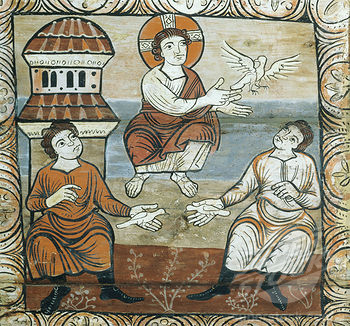Each week for the past many years, Garrison Keillor has told “Prairie Home Companion” listeners the news from Lake Wobe![Lake-Wobegon[1]](https://wp-media.patheos.com/blogs/sites/766/2012/12/lake-wobegon1.jpg?w=150) gon, where “all the women are strong, all the men are good-looking, and all the children are above average.” I’ll bet the Holy Family was like that.
gon, where “all the women are strong, all the men are good-looking, and all the children are above average.” I’ll bet the Holy Family was like that.
Lots of people think their children are well “above average”—hence, the bumper stickers in which parents boast that they are the “Proud Parents of an Honor Student at _________.”![]() Everyone thinks their child is precocious and the smartest/best looking/most creative human being ever. Every parent expects their infant to earn either a full academic or full athletic scholarship (probably both) to the college of their choice when the time comes. I doubt there is a place for a bumper sticker on a donkey, but if there is, what would Mary and Joseph’s donkey sticker have said?
Everyone thinks their child is precocious and the smartest/best looking/most creative human being ever. Every parent expects their infant to earn either a full academic or full athletic scholarship (probably both) to the college of their choice when the time comes. I doubt there is a place for a bumper sticker on a donkey, but if there is, what would Mary and Joseph’s donkey sticker have said?![b24ede2f59b807e062898eb6a63bb5de[2]](https://wp-media.patheos.com/blogs/sites/766/2012/12/b24ede2f59b807e062898eb6a63bb5de2.jpg?w=150) “Proud Parents of the Savior of the World”? “Our Kid is God in the Flesh”? Because there’s precocity, and then there’s precocity.
“Proud Parents of the Savior of the World”? “Our Kid is God in the Flesh”? Because there’s precocity, and then there’s precocity.
In “The Nativity Story,” a significant amount of time is spent on Mary and Joseph’s journey from Nazareth south to Bethlehem. The filmmaker creatively lets us spend some time with these two young people, almost strangers to each other, who have been named as players in a divine plan that they have been told very little about. At one point, Mary asks Joseph what the angel had said to him.
Joseph: He said to not be afraid. (pause) Are you afraid?
Joseph: Yes.
Mary: Do you ever wonder when we’ll know? That he is not just a child? Something he says, a look in his eyes?
Joseph: Sometimes I wonder will I be able to even teach him anything.
No kidding. When it is predicted by the angels that the soon-to-be-born baby will “save his people from their sins,” one’s possible parental and step-parental contributions certainly seem to pale in comparison.
Although you wouldn’t know it from the mass quantities of commentary and artwork that have been produced over the last two thousand years, the canonical Gospels tell us remarkably little about holy family life. The non-canonical gospels, however, contain some stories that entirely corroborate Mary and Joseph’s pre-birth concerns.  Jesus makes clay birds, which then come to life and fly away. Jesus strikes an annoying playmate dead. Jesus brings a less annoying playmate back to life after a fatal accident. School is a disaster, since every time a teacher tries to teach Jesus something, Jesus starts doing the teaching instead. Joseph and Mary’s worst fears come true.
Jesus makes clay birds, which then come to life and fly away. Jesus strikes an annoying playmate dead. Jesus brings a less annoying playmate back to life after a fatal accident. School is a disaster, since every time a teacher tries to teach Jesus something, Jesus starts doing the teaching instead. Joseph and Mary’s worst fears come true.
The canonical gospels essentially leave us in the dark about Jesus between birth and thirty years old. We get the circumcision, the three kings, the flight to Egypt, Jesus growing in wisdom and stature, and a central text from Luke 2, twelve-year-old Jesus in the temple. The various artist’s renditions I’ve seen of this story are pretty much the same—![The-Jesus-2[1]](https://wp-media.patheos.com/blogs/sites/766/2012/12/the-jesus-21.jpg?w=300) Jesus, looking particularly Aryan in the center of a holy glow, pontificates and astounds while his learned elders in the shadows lean away in disbelief and awe and some scribe takes notes. It’s kind of how I remember myself as a fifth or sixth grader, astounding (annoying?) my teacher and fellow students with yet another piece of fascinating (to me), but useless (to anyone else) information. Lovely scene, except that it has a lot more to do with what we think Jesus at twelve would have been like than anything from the story in Luke.
Jesus, looking particularly Aryan in the center of a holy glow, pontificates and astounds while his learned elders in the shadows lean away in disbelief and awe and some scribe takes notes. It’s kind of how I remember myself as a fifth or sixth grader, astounding (annoying?) my teacher and fellow students with yet another piece of fascinating (to me), but useless (to anyone else) information. Lovely scene, except that it has a lot more to do with what we think Jesus at twelve would have been like than anything from the story in Luke.
The actual story gives us a glimpse into a real family, holy or not. After going to the feast in Jerusalem with friends and family, as is their annual custom, Mary and Joseph are returning north to Nazareth. Although they’re not sure where Jesus is, they assume that he’s running around with his friends somewhere in the traveling group, so they don’t worry about it. Good for them—he’s almost a teenager, and they’ve loosened the parental leash a little bit. Let the boy have some freedom. But when he doesn’t show up at the end of the day, they’re worried. After failing to find him in the caravan, they return in panic to Jerusalem, where after three days they find him in the temple “sitting in the midst of the teachers.” In response to his mother’s exasperated and relieved “What the hell is your problem?? We’ve been looking all over for you!!! We thought you’d ![262jesus12[1]](https://wp-media.patheos.com/blogs/sites/766/2012/12/262jesus121.jpg?w=300) been kidnapped!!!!”, Jesus gives a predictable, smart-alecky twelve-year-old response: “Why is it that you sought me? Did you not know that I must be about My Father’s business?” Oh really?? “Guess what? You’re grounded! Once we get back to Nazareth you can ‘be about your Father’s business’ in your room!!” Luke chooses not to tell us if Jesus then received a well-deserved slap upside the head and lived under house arrest for the next year.
been kidnapped!!!!”, Jesus gives a predictable, smart-alecky twelve-year-old response: “Why is it that you sought me? Did you not know that I must be about My Father’s business?” Oh really?? “Guess what? You’re grounded! Once we get back to Nazareth you can ‘be about your Father’s business’ in your room!!” Luke chooses not to tell us if Jesus then received a well-deserved slap upside the head and lived under house arrest for the next year.
This is a real family, struggling with the challenges of love, faith, boundaries, and growing up. Despite the usual interpretations of this story, I think that Jesus had not gone to the Temple to school the experts—something he presumably could have done, given his pedigree and all. He was “sitting in the midst of the teachers, both listening to them and asking them questions.”![Jerus-n4i[1]](https://wp-media.patheos.com/blogs/sites/766/2012/12/jerus-n4i1.jpg?w=300)
I don’t know whether twelve-year-old Jesus thought he was the Son of God—my bet is that he didn’t. But he did know where he wanted to be—he wanted to be where he could learn. Certainly the mystery and splendor of the Temple would have been an attraction for any young Jewish boy. But the real attraction was that this is where learning happened. This is where the most intelligent and educated people of Jesus’ society gathered to debate, to investigate, to discuss, and to discover. And that’s where Jesus wanted to be—listening and asking questions. Even the Son of God had a lot to learn and knew how to get started. Put yourself in the right place and open yourself up.
Reflecting on this will be a wonderful preparation for the upcoming semester. The life of learning is so much more about quietness, attentive listening, and perceptive questions than conveying facts and information.![ListenLearn-lg[1]](https://wp-media.patheos.com/blogs/sites/766/2012/12/listenlearn-lg1.gif) This is where the divine in each of our human vessels gets awakened and fanned into flame. It’s a privilege to participate. When, as always happens, I find myself buried under and frustrated by piles of grading and endless department and committee meetings in a few weeks, I’ll try to remember twelve-year-old Jesus, who knew where he belonged. He was about his Father’s business. Go and do likewise.
This is where the divine in each of our human vessels gets awakened and fanned into flame. It’s a privilege to participate. When, as always happens, I find myself buried under and frustrated by piles of grading and endless department and committee meetings in a few weeks, I’ll try to remember twelve-year-old Jesus, who knew where he belonged. He was about his Father’s business. Go and do likewise.













